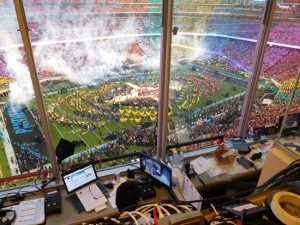Carolina Panthers Broadcast with Allen & Heath
 Charlotte, NC – As one of the few NFL football teams to own its own broadcasting network, the Carolina Panthers are well equipped to serve their fan base. The Panthers Radio Network broadcasts game day programming, a post-game show and a variety of special programs. Selected programs are also streamed at panthers.com.
Charlotte, NC – As one of the few NFL football teams to own its own broadcasting network, the Carolina Panthers are well equipped to serve their fan base. The Panthers Radio Network broadcasts game day programming, a post-game show and a variety of special programs. Selected programs are also streamed at panthers.com.
Broadcasts are mixed on an Allen & Heath Qu-16 digital mixer which travels with the team to away games. Technical Producer Harrill Hamrick sets up the system and mixes the broadcasts. His goal is to create an engaging live program by seamlessly combining local sources like the play-by-play announcer, locker-room interviews and crowd microphones with remote announcements and advertisements fed over a tie-line from the Panthers’ broadcast station.
Hamrick had used a 16-channel analog mixer for several years. “The analog mixer was old enough that I knew I needed to replace it,” he said. “I was concerned about reliability and the sound quality had suffered from things like capacitors drying out.” Hamrick looked at several new mixers and says he was attracted to the advantages of digital mixing but he was concerned about setup complexity and a lengthy learning curve.
Cliff Miller of SE Systems in Greensboro, NC recommended the Qu-16 as a great way to move up to digital while maintaining ease of use. When he first received the mixer, Hamrick says he connected his sources and was able to configure and use it quickly. “The Qu-16 has an analog feel to it,” he says, “and you don’t get lost in the layers and the complexity.”
During broadcasts, a Qu-16 mix feeds the studio and another goes to the Spanish-language broadcaster. Additional Qu-16 outputs feed local monitor mixes. An Allen & Heath ME-1 Personal Mixer with Lectrosonics wireless transmitter and receiver enables a custom monitor mix for the producer as he wanders around the booth and into the stadium. Hamrick carries the Qu-16 in a portable case and sets up the overall system quickly using CAT5 cables for both digital and analog connections. He chose the ISDN transmission protocol to send programs to the station. ISDN allows modern digital connections even over traditional twisted-pair telephone lines.
The Qu-16’s “Qu-Drive” feature provides a multi-track recording of Panthers’ games and its two-track output feeds a pair of Sony PCM recorders. Hamrick uses the Qu-16’s compression and EQ on selected microphones and saves the entire Qu-16 configuration to a USB thumb drive as a backup.
The Qu-16 has become the heart of the Panthers Radio broadcast system. Hamrick loves the mixer’s compact profile and says it has “a nice clean sound – much better than the old analog mixer.” He added, “The Qu-16 is in a sweet spot for this job. It has plenty of inputs and processing power in a well-built, small package at an attractive price. I couldn’t do a broadcast now without it!”


